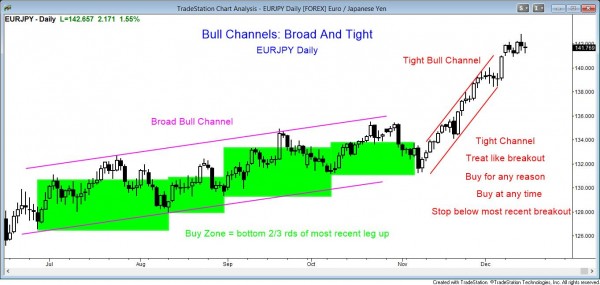Ninety per cent of the time, the market is either in a channel or in a trading range, and it is better to buy at support and sell at resistance. This a good Forex trading strategy…in fact it is a good trading strategy for any market. In a bull channel, support might be the bottom of the channel or just above a recent minor higher low. During the other 10% of the time, the market is in a successful breakout phase of a trend. It is then better to enter as soon as you believe the breakout is successful instead of waiting for a pullback, which might not come for many bars. Since the stop is often far away during a breakout, traders have to adjust their position sizes and their profit targets.
Forex trading strategies in channels on the daily Forex chart

The daily chart of the EURJPY Forex market was in a broad bull channel until November and the broke out into a tight bull channel. Traders trade the two situations differently.
When the market is in a broad bull channel, it is making higher highs and lows, but the pullbacks are deep, often more than 50% of the prior bull leg. For example, the market had a bull leg from the bar 7 low to the bar 8 high, and the pullback down to the bar 9 low retraced about 75% of that rally. Each deep pullback forms a higher low and is followed by a new high. Because the market sells of strongly from each new high, the market has strong two-sided trading and is basically the same as a trading range that is sloped upward slightly. When the bears are strong like this, traders like to trade in both directions, just like when the market is in a trading range. They BLSHS…Buy Low, Sell High, and scalp. It does not matter whether it is Forex market, the Emini, commodities, stocks, or anything else because it is the same traders and computers making the trades and they trade the price action the same.
Since it is a bull channel, it is a bull trend, and traders will try harder to buy. Some prefer to only enter with stop orders above strong bull reversal bars, especially when there is a second entry, like above bar 7 (the first buy signal was 2 days earlier). They but with a stop order 1 pip (tick) above the high of the bar and put a protective stop 1 pip below, and try for a swing up (a swing is a trader where the trader is holding for a profit that is at least twice as large as his risk).
Other traders will buy at fixed intervals, like 100 pips or 200 pips down, or at 25, 50, and 75% down, or at Fibonacci levels. Some like to buy the closes of strong bear bars in the bottom third of the prior leg, like the close of the bar three bars before bar 7.
Bears will short at the prior high and scale in high. For example, they will short as bar 10 sent above the bar 4 high and they will scale in higher, like maybe 100 pips higher. They might risk a measured move up, meanding they they might have a protective stop that is 50 to 100% the height of the range (if the prior leg was 400 pips, they might risk 200 pips). Others will get out if the market started to have 2 or 3 consecutive bull bars closing near their highs. This could be a sign that the market was breaking out, as happened in the move from the bar 17 low to the bar 18 high where there were 5 bull bars closing near their highs.
Once the market begins to breakout, traders switch to trend trading. Since there was a bull breakout, they would only look to buy.


Do you not think the forex market does have some slightly different characteristics than stocks and the eminis Al? For example it seems to me like channels accelerate into stronger trends more often in forex, in contrast to the usual market cycle of breakout->channel->TR? i see this a lot around the time the London traders begin trading, as in the market is in a TR or weak channel overnight, and then starts trending harder at 7-9am GMT. Any thoughts on this? Or other quirks you have noticed with forex?